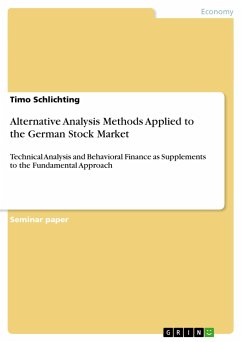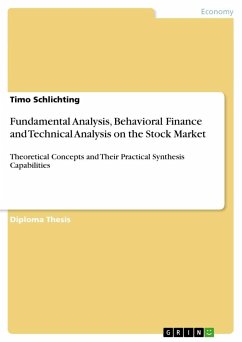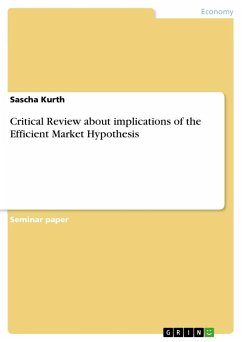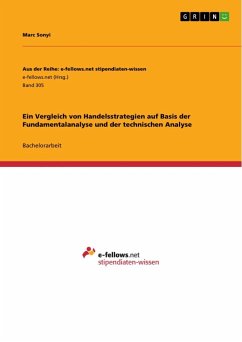
Alternative Analysis Methods Applied to the German Stock Market
Technical Analysis and Behavioral Finance as Supplements to the Fundamental Approach

PAYBACK Punkte
0 °P sammeln!
Seminar paper from the year 2008 in the subject Business economics - Investment and Finance, grade: 1,0, University of Applied Sciences Essen, language: English, abstract: The price movements of stocks are the result of complex interdependencies due to a vast number of influencing factors - such as fundamental and psychological factors - are expressed in the expectations and the behavior of the stock marketparticipants. To cope with this complexity and to derive an applicable asset strategy, analysts distinguish particularly between two dominant analysis methods in practice - the Fundamental a...
Seminar paper from the year 2008 in the subject Business economics - Investment and Finance, grade: 1,0, University of Applied Sciences Essen, language: English, abstract: The price movements of stocks are the result of complex interdependencies due to a vast number of influencing factors - such as fundamental and psychological factors - are expressed in the expectations and the behavior of the stock marketparticipants. To cope with this complexity and to derive an applicable asset strategy, analysts distinguish particularly between two dominant analysis methods in practice - the Fundamental and the Technical Analysis - which have recently been supplemented by the approach of Behavioral Finance.With reference to a strict interpretation of the theoretical assumptions of the Fundamental as well as the Technical Analysis these two concepts are mutually exclusive. As a result of this there are a vast number of analysts who either acknowledge the Fundamental Analysis while denying theTechnical Analysis and vice versa. The Fundamentals criticize that the technical approach has a lack in academic foundation and is, therefore similar to a kind of reading tea leaves, whereas theTechnicals are convinced that the Fundamental Analysis is not able to generate an advantage by analyzing the fundamental value drivers of a stock, because those are already reflected by the current market prices. In practice the Fundamental Analysis seems to have its weaknesses particularly during extreme market phases - e.g. during the New Economy bubble at the end ofthe nineties - in which the psychology of the market participants gains in impact. At the same time the fundamental aspects are seemingly neglected. Furthermore, the fundamental approach seems to have improvement capabilities particularly in terms of timing.Psychological aspects of the market participants are at least indirectly included within the Technical Analysis, which could be particularly used for timing decisions as well. Nevertheless, it has its weaknesses too, e.g. it does not provide clearly defined interpretation rules for its various numbers of chart patternsand technical indicators. Behavioral Finance seems to have its existence authority in practice as well, due to decisions in stock markets made by human beings, who do not always behave totalrationally. All these aspects lead to the master question if the two alternative analysis methods - Technical Analysis and Behavioral Finance - can deliver any useable supplements towards the Fundamental Analysis in terms of their practicalapplication?













